Temporal Branding: Why the Future of Some Brands Is Temporary
Introduction
Branding has always been associated with permanence. We picture logos carved in stone, colour palettes and typefaces designed to stand the test of time, and campaigns that aim to reinforce recognition over decades. Yet in today’s culture of hyper-speed trends and shrinking attention spans, a different kind of branding is gaining ground. This is temporal branding, the creation of identities that are intentionally short-lived, designed to exist only for a fleeting moment before disappearing.
From pop-up shops and seasonal packaging to one-off digital campaigns, temporal branding thrives on urgency and exclusivity. Far from being wasteful or superficial, this approach can deepen customer engagement and cement cultural relevance. However, it also carries risks, particularly when it comes to long-term brand equity. In this article we will explore what temporal branding is, why it works, where it has been successful, and how businesses can use it wisely.
What is Temporal Branding?
Temporal branding refers to the deliberate creation of brand identities, campaigns, or experiences that are temporary by design. Unlike legacy branding, which is built for consistency and endurance, temporal branding thrives on the opposite. Its defining features are:
Ephemerality: The brand or campaign is meant to last for a set period only.
Exclusivity: Its short duration makes it scarce and often desirable.
Cultural timing: It is linked to a specific season, event, or trend.
This can take many forms, including:
Limited edition packaging or product designs.
Pop-up shops in unexpected locations.
Seasonal offerings such as festive menus or holiday-themed merchandise.
Temporary digital campaigns tied to trending moments.
The appeal of temporal branding lies in its ability to tap into the psychology of urgency and the fear of missing out. Customers know that if they do not engage now, the opportunity will be gone.
Why Temporal Branding Works
Several psychological and cultural drivers explain why temporal branding resonates so strongly with today’s audiences.
1. Scarcity and FOMO
Humans are hardwired to value things that are scarce. When a product or experience is only available for a short period, it instantly feels more precious. Temporal branding leverages this instinct to increase demand.
2. Constant Novelty
In the attention economy, brands must fight to remain interesting. A constantly refreshed identity, whether seasonal or campaign-based, ensures that audiences keep paying attention.
3. Alignment with Digital Culture
Online trends rise and fall in days. Temporal branding mirrors this rhythm, helping brands appear relevant and agile. The internet rewards freshness and novelty, and short-lived branding fits perfectly into this ecosystem.
4. Emotional Connection
Moments in time can be deeply emotional. A festive campaign or event-specific activation creates a sense of shared memory. Customers associate the brand with that moment, even if the branding itself vanishes afterwards.
Case Studies of Temporal Branding
Starbucks Seasonal Cups
Every year Starbucks unveils limited-edition festive cups. They spark online chatter, customer anticipation, and countless social media posts. Although the designs disappear after the season, they reinforce a sense of tradition and excitement.
Supreme and Drop Culture
Streetwear label Supreme has perfected temporal branding through its drop model. Each product release is limited in quantity and available for a short window. Items sell out quickly, driving resale markets and cult loyalty.
IKEA Pop-Ups
IKEA has experimented with pop-up shops in major cities, offering curated selections and immersive experiences. These temporal spaces generate buzz, test new markets, and attract press coverage.
Music Festival Collaborations
Brands that create temporary activations at festivals such as Glastonbury or Coachella benefit from intense but fleeting attention. The branding may exist only for a weekend, yet it leaves behind social media impressions and lasting associations.
Benefits of Temporal Branding
Buzz Generation
Short-lived campaigns generate talkability. Audiences feel compelled to share before the moment is over.Market Testing
Temporary branding allows brands to trial new ideas, products, or designs without long-term commitment.Cultural Relevance
By tying branding to specific events or moments, businesses can feel current and in tune with their audience.Customer Loyalty through Anticipation
If audiences know something will return annually or seasonally, such as festive branding, they look forward to it.Agility and Adaptability
Temporal branding shows that a business can move quickly, a valuable trait in competitive industries.
Risks and Challenges
Despite its appeal, temporal branding is not without challenges.
Dilution of Brand Equity
If a brand changes its identity too often, it risks weakening its core recognition. Customers may struggle to connect temporary expressions back to the main brand.
Fatigue and Overuse
Scarcity works only if it feels authentic. If every campaign is limited-time or “exclusive”, audiences may become sceptical and disengaged.
Sustainability Concerns
Physical temporal branding, such as packaging or pop-ups, can create waste. In an era of growing environmental awareness, brands must balance excitement with responsibility.
Accessibility Issues
Temporal branding may alienate customers who cannot participate in the moment, leading to frustration instead of loyalty.
How to Implement Temporal Branding Wisely
Anchor in Core Identity
Ensure every temporary expression still connects back to the brand’s long-term identity. Seasonal campaigns should feel like variations, not complete departures.Use Temporal Branding Sparingly
Scarcity loses impact when it is overused. Reserve temporal branding for special occasions or strategic campaigns.Build Anticipation
Tease limited editions or pop-ups in advance to maximise buzz and ensure customers are ready to engage.Think Sustainable
Design temporary campaigns in environmentally conscious ways. Recyclable materials, digital-first experiences, and repurposed assets can reduce impact.Measure Impact Beyond Sales
Temporal branding is not only about revenue. Track engagement, cultural conversation, and long-term brand sentiment to judge success.
The Future of Temporal Branding
As technology advances, we may see even more radical forms of temporal branding. Artificial intelligence could enable brands to generate micro-identities that change weekly or daily, customised to specific communities or contexts. Virtual and augmented reality may allow brands to create immersive identities that vanish once the event is over.
Yet permanence still matters. Strong brands need a consistent foundation that can withstand cultural shifts. The most successful strategies will blend the best of both worlds: a recognisable core identity paired with agile, temporal expressions that respond to the moment.
Conclusion
Temporal branding is not a replacement for traditional branding but a powerful complement to it. In a culture that values novelty, urgency, and cultural relevance, short-lived brand identities can drive attention, loyalty, and engagement. The challenge lies in using them with precision and care, ensuring they enhance rather than undermine the long-term brand story.
For businesses looking to innovate, the question is not whether temporal branding is right, but how it can be harnessed without losing sight of the bigger picture. After all, sometimes the most lasting impression is made by something that was never meant to last.

